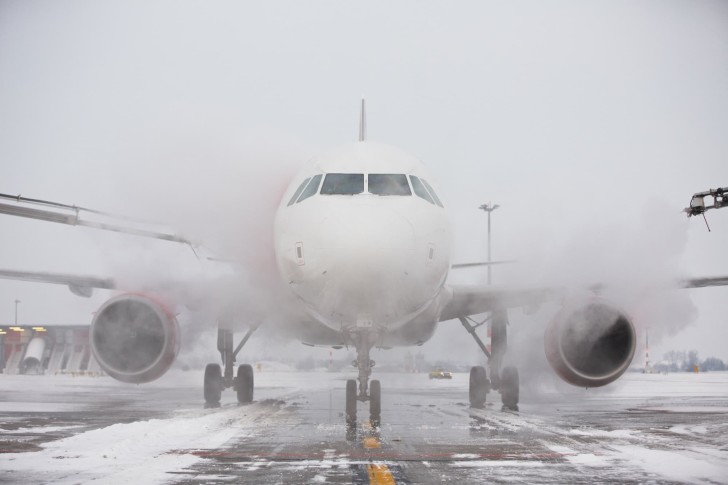Boeing Files Patent for Technology to 3D Print Artificial “Ice,” Easing the Aircraft Certification Process
 When it comes to utilizing 3D printing technology within the aerospace industry, very few companies—aside from Airbus perhaps—have been experimenting as much as Boeing. Over the last year or so, Boeing has patented a 3D printing process that prints levitating objects, and has also found a home for a over 20,000 3D printed parts on their Boeing aircraft line. The Chicago-headquartered aircraft manufacturer has showed no signs of cooling down either (pun slightly intended), having filed an application to the US Patent Office for their freshly developed process to 3D print artificial “ice.” Now, you won’t find this technology in your next complimentary on-flight refreshment, nor anywhere else on the commercial aircraft for that matter.
When it comes to utilizing 3D printing technology within the aerospace industry, very few companies—aside from Airbus perhaps—have been experimenting as much as Boeing. Over the last year or so, Boeing has patented a 3D printing process that prints levitating objects, and has also found a home for a over 20,000 3D printed parts on their Boeing aircraft line. The Chicago-headquartered aircraft manufacturer has showed no signs of cooling down either (pun slightly intended), having filed an application to the US Patent Office for their freshly developed process to 3D print artificial “ice.” Now, you won’t find this technology in your next complimentary on-flight refreshment, nor anywhere else on the commercial aircraft for that matter.
In fact, Boeing is actually planning to use this unique 3D printing process in order to streamline the strict aircraft certification standards process at a greatly reduced cost. At first glance, you may not see ice crystals as much of a threat to modern day aviation. But in reality, ice buildups on aircraft wing edges can pose a substantial risk, such as aerodynamic degradation and increased risk of a fatal stall while in-flight. This dilemma has led the United States Federal Aviation Administration (FAA), among other international aeronautical entities, to require certification that all new aircraft can safely operate in the iciest of situations.
The current methods of testing this involves supercooled wind tunnels, which allow for massive ice buildup on the aircraft surface. This buildup is then replicated in the same ice texture using glassfiber and resin material, which is then attached to the aircraft and tested for proper functioning while in-air. The traditional process may work well enough, but according to Boeing, it comes with a number of hindrances, including high cost, imprecision, time constraints, and lack of variable control, as well as the knack to cause damage to the aircraft being tested.With their newly patented method, however, this is shaping up to be a much more efficient process. The artificial “ice” shapes are first designed with CAD, with all the necessary density and textural properties included into the design. These files will then be built up layer by layer to ensure the complex inner structure that is embedded in natural icing conditions. Instead of going through the lengthy and costly traditional testing method, Boeing will be able to simply design the icing conditions from a computer, allowing them to achieve the aimed rigidity, thickness, and other specified conditions needed to appropriately test their new aircraft.According to Boeing, these artificial “ice” shapes will be able to printed with unique identification codes and markers, which will allow these structures to be properly fit and easily attributed. This new aircraft certification system was invented by Boeing researchers Cris Bosetti, Fred Krueger, Ian Gunter, and Dean Walters, who have based the process on a high-level flowchart engineered to reduce the fabrication to the everyday 3D files, which can be utilized with a handful of 3D printing processes and materials. All in all, the patent—filed September 16, 2014 and published March 17, 2016—will allow Boeing to single-handedly improve the way by which icing conditions are tested on newly manufactured aircraft. Any thoughts on this new technology? Discuss in the 3D Printed Ice forum over at 3DPB.com.
[Source: Patent / Image: Gizmag]Subscribe to Our Email Newsletter
Stay up-to-date on all the latest news from the 3D printing industry and receive information and offers from third party vendors.
You May Also Like
3D Printing Unpeeled: New Arkema Material for HP, Saddle and Macro MEMS
A new Arkema material for MJF is said to reduce costs per part by up to 25% and have an 85% reusability ratio. HP 3D HR PA 12 S has been...
3D Printing News Briefs, January 20, 2024: FDM, LPBF, Underwater 3D Printer, Racing, & More
We’re starting off with a process certification in today’s 3D Printing News Briefs, and then moving on to research about solute trapping, laser powder bed fusion, and then moving on...
3D Printing Webinar and Event Roundup: December 3, 2023
We’ve got plenty of events and webinars coming up for you this week! Quickparts is having a Manufacturing Roadshow, America Makes is holding a Member Town Hall, Stratafest makes two...
Intuitive Machines Debuts $40M Hub for Lunar Ambitions and 3D Printing Tech
Best known for its pioneering work in lunar exploration and its development of the Nova-C lunar lander, Intuitive Machines (Nasdaq: LUNR) has marked yet another significant milestone. The leading space...

































